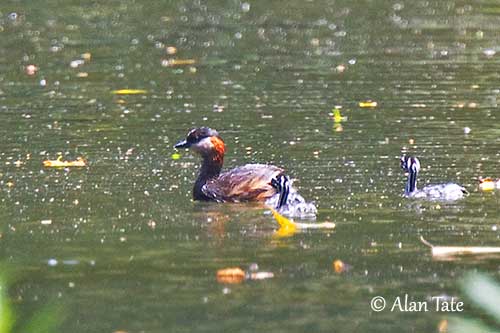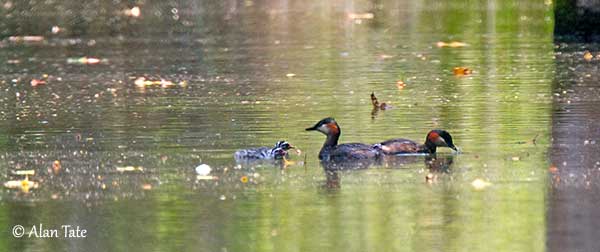
PROTECTION / THREATS / STATUS:
The Madagascan Grebe is threatened in W by reduction of its habitat for rice cultivation and other crops, but also by introduction of exotic fish, especially herbivorous species that destroy and limit the development of the aquatic vegetation. Intensification of fishery practices involving death of birds trapped in fishing nets, predation by carnivorous fish, use of pesticides and hunting pressure are important threats too.
The population is estimated to number at least 5,000 individuals, roughly equivalent to 3,300 mature individuals. It is suspected to be in decline.
The Madagascan Grebe is currently listed as Vulnerable.
Fr: Grèbe malgache
Ang: Madagascan Grebe
All: Madagaskarzwergtaucher
Esp: Zampullín Malgache
Ita: Tuffetto del Madagascar
Nd: Pelzelns Dodaars
Sd: madagaskarsmådopping
Mal: Kiborano, Tsiriry, Vivy
Photographers:
Jean Michel Fenerole
Photos d’Oiseaux du monde
William Price
PBase-tereksandpiper & Flickr William Price
Dubi Shapiro
Dubi Shapiro Photo Galleries & Dubi Shapiro's Pictures on IBC
Alan & Ann Tate
AA Bird Photography
Text by Nicole Bouglouan
Sources:
HANDBOOK OF THE BIRDS OF THE WORLD vol 1 by Josep del Hoyo-Andrew Elliot-Jordi Sargatal - Lynx Edicions - ISBN: 8487334105
The Birds of Africa: Volume VIII: The Malagasy Region: Madagascar, Seychelles, Comoros, Mascarenes - Par Roger Safford, Frank Hawkins – ISBN: 1408190494, 9781408190494- Editeur: A&C Black, 2013
Birds of the Indian Ocean Islands Par Ian Sinclair, Olivier Langrand - ISBN: 1868729567, 9781868729562- Editeur: Struik, 2003
Birds of Madagascar: A Photographic Guide Par Pete Morris, Frank Hawkins – ISBN: 0300077556, 9780300077551- Editeur: Yale University Press, 1998
Wikipedia, the free encyclopaedia
Arthur Grosset's Birds (Arthur Grosset)
Madagascan Grebe
Tachybaptus pelzelnii
Podicipediformes Order – Podicipedidae Family
INTRODUCTION:
The Madagascan Grebe is endemic to Madagascar. It occurs throughout the island except in the drier southern regions. It frequents water bodies with abundant aquatic vegetation from sea-level to 2,000 metres of elevation. It feeds on aquatic prey such as insects, small fish and crustaceans caught by diving or from water surface. It nests on floating platform well away from the shores.
The Madagascan Grebe is threatened by habitat loss, conversion of wetlands, introduction of exotic fish that destroy the aquatic vegetation, and hunting. The population is declining and the species is listed as Vulnerable.

DESCRIPTION OF THE BIRD:
Biometrics:
Length: 25 cm
Weight: M: 177 g – F: 145 g
The Madagascan Grebe in breeding plumage has brownish-grey upperparts. On the upperwings, the wing-coverts are brownish-grey, but secondaries and inner primaries are white with dark outer webs. The outer primaries are blackish-brown.
On the underparts, chin and throat are ashy-grey with slightly paler chin. Body sides and flanks are brownish-grey with whitish wash. The belly is white.
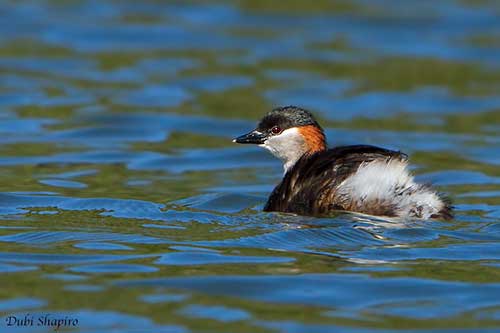
On the head, forehead and crown are blackish, extending to just before the eye and forming a narrow band on central hindneck. The face is ashy-grey. A white line can be seen behind the eye. The neck is brownish-grey, with reddish-chestnut sides of upper neck.
The bill is blackish with white tip. The eyes are deep red. Legs and lobbed feet are olive.
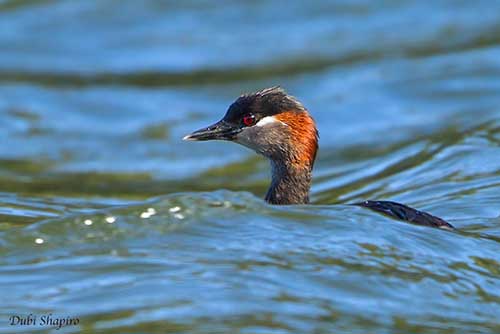
The adult in non-breeding plumage is duller and paler. The foreneck is whiter and there is no chestnut on the upper neck sides. The bill is mostly yellowish.
Male and female are similar in plumage, but the female is slightly smaller than male.
The juvenile resembles non-breeding adult, but it has buffy-white stripes on head and neck.
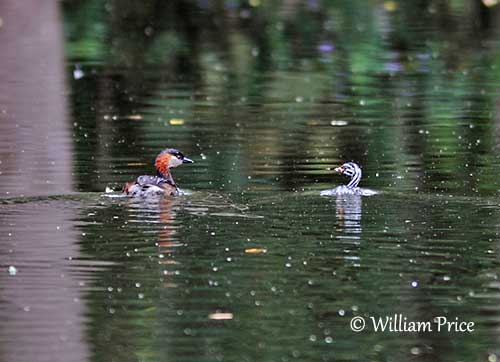
RANGE:
The Madagascan Grebe occurs throughout the island, but it is absent in the drier parts of S and SW.
HABITAT:
The Madagascan Grebe frequents permanent or temporary water bodies with abundant vegetation including water lilies Nymphaea stellata. It prefers freshwaters, but it is sometimes recorded in brackish waters or slow-flowing rivers. The species is visible from sea-level to 2,000 metres of elevation.
CALLS AND SONGS: SOUNDS BY XENO-CANTO
The Madagascan Grebe gives low, slightly trilled “kerk”. The song is a low trill of 2-4 seconds, dropping at the end “drrrrrrrrrrrrrrrrrrrk”. They are more vocal during the breeding season.
BEHAVIOUR IN THE WILD:
The Madagascan Grebe feeds on aquatic insects, small fish and occasionally crustaceans. It forages by diving like other grebes. However, it also catches food items from water surface while swimming.
From several observations, feathers were found in stomachs, indicating that they sometimes eat their own feathers to protect themselves against the fish bones. Later, pellets are regurgitated, containing both feathers and fish bones.
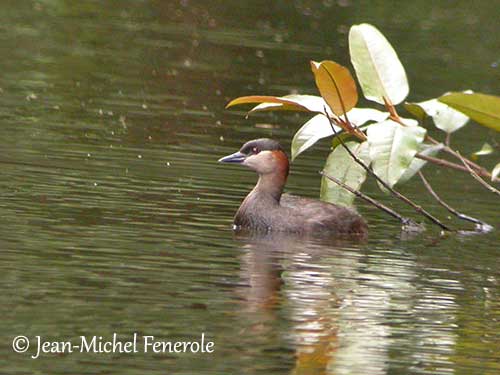
During the breeding season, the Madagascan Grebe becomes territorial. They nest on floating platforms anchored well offshore, often in areas with water lilies. They are solitary nesters.
The courtship displays of this species are unknown, but we can suggest that this behaviour resembles that of other grebes, with several ceremonies between mates accompanied by calls. Copulation takes place out of water, usually on platform of vegetation built on shallow water.
The Madagascan Grebe is often found in flocks outside breeding season, and loose flocks may contain several tens, sometimes up to 100/150 individuals.
The species disperses and moves from lake to lake when they dry out or reduce in size. These movements are more frequent in the seasonally dry W.
The Madagascan Grebe does not walk easily on the ground but it is a very good swimmer. But like several island forms, it has reduced ability to fly due to relatively short wings and tail.
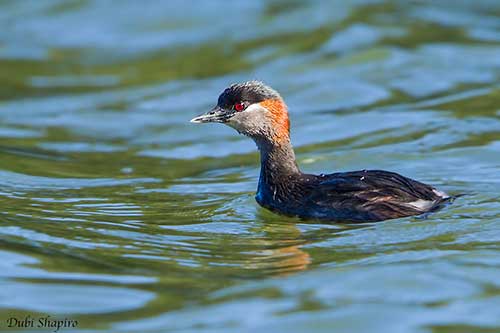
REPRODUCTION OF THIS SPECIES:
The breeding season takes place at end of the rainy season, between February and April, but also between August and October during the austral spring.
The Madagascan Grebe is solitary nester, although some nests may be only tens of metres apart. The nest is a floating platform with a shallow depression on top. It is made with pieces of aquatic plants, leaves and bits of soft reed rhizomes, and rotten or fresh material. It may be anchored to aquatic plants, or close to masses of floating vegetation. It is built on small ponds, lakes or stretches of slow-flowing rivers, and it is usually well offshore among water lilies.
The female lays 3-4 pale bluish or whitish eggs that soon become stained from contact to wet nest material. The incubation is unknown, but it usually lasts from 20 to 30 days according to the species. The chicks are precocial and leave the nest very soon after hatching. They are able to dive to hide themselves if they are threatened or disturbed. They depend on parents for food during several weeks, from 44 to 79 days depending on the species.
